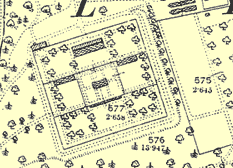The ‘Cally Gardens’ of today were built 1765-1770 as the walled kitchen garden for Cally House, near Gatehouse of Fleet, Kirkcudbrightshire. Over 1 hectare in size, the area is enclosed by brick walls up to 15ft in height, and would originally have been sub-divided by 2 heated internal walls running east-west across the garden. Of the original buildings, the gardener’s cottage and a large lean-to vinery remain, backing onto potting sheds, fruit store, mushroom house and boiler house.
The 25” to one mile Ordnance Survey map published in 1895 shows the layout of the gardens just before the long deterioration that began with the Great War. Note the internal walls and number of glasshouses.
Walled Kitchen Gardens
A walled kitchen garden, or the remains of one, is to be found on many of the larger country estates. Built at great expense, mostly between 1750 and 1880, their glasshouses and sheltering walls were the only way to enjoy a constant supply of exotic fruit and vegetables. These days fresh food is flown in from all over the world at all seasons to fill the supermarkets. Before the days of airplanes and freezers almost as wide a variety of produce was supplied, to the wealthy few, by an army of skilled gardeners. They worked without the help of modern chemicals, plastics, thermostats etc., but did have the benefit of a uniquely adapted artificial environment- the walled garden. A well run walled kitchen garden was the high point of horticulture as a craft.
Decline and Change
After the Great War, social and economic changes caused many country estates around the UK to go into decline, Cally among them. The kitchen garden became an anachronism; a high demand for fuel and labour in stark contrast to the mass production of ‘food for all’ allowed by mechanisation. Sold to the Forestry Commission in 1939, Cally Gardens became a tree nursery, before being sold on again, this time to the late Brian Taylor, under whom it became well known for cut flowers and fuchsias.
The Cally Gardens Nursery 1987 present
Michael Wickenden bought Cally Gardens in 1987, after a 10-year search for a walled garden in which to develop his specialist nursery. A walled garden, carefully located by the original owners, and with over 200 years of soil improvement, seemed an ideal site for a nursery. In turn, the nursery would provide the means to restore and maintain this remarkable garden. To ensure the historic value of Cally is not forgotten, and to afford it some protection for the future, the site is now grade II listed.

